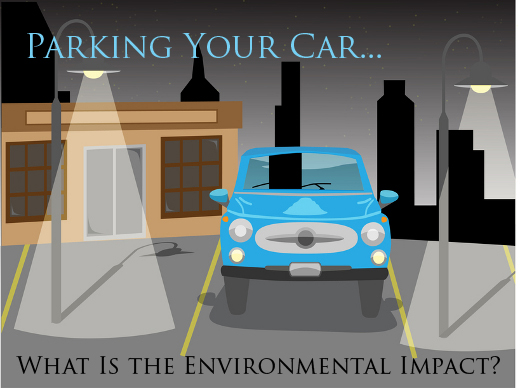When we think about cars on the road and their environmental and economic impact we typically think of certain hot button topics. We might think of fuel economy or alternative methods of powering our vehicles. We might think of the impact of factories and cars globally and locally. We might think about pollution from manufacturing and from consumption (driving). We might think about the life cycle of the vehicles we purchase or whether to buy new or used. There are numerous issues we can chat about surrounding cars as a dominant form of transportation but one we rarely talk about, at least in my opinion, is parking. We live in a car obsessed culture and we need somewhere to park our beloved cars. What is the impact though?
All over the country you will see businesses surrounded by huge parking lots, many of the spaces sitting empty unless it is during peak shopping hours. I have always thought it seemed like an incredible waste of land but what are retailers to do? They want to make sure every potential customer has a place to park to encourage shopping. If they don’t do this then they lose sales right? Consumerism drives our economy so we do have to be concerned with the economics of parking.
We also need to be concerned with the environmental impact of parking. There IS an environmental impact. Remember the Joni Mitchell song… “They paved paradise and put up a parking lot”. It is not just an issue of aesthetics. We lose land to build these huge, wasteful structures and they are not eco friendly in the least. Think about the unsustainable building materials being used and all the land being used inefficiently. According to a new report, there are an estimated 3 to 8 parking spaces available for every car on the road. That is a lot of unused space!
Of course some municipalities are going vertical and creating parking structures and garages. This report though shows that between 80-90% of parking demand is still served by surface lots (outward expansion, waste of land/space). Building and maintaining these lots and structures needs to be added to the cumulative planetary impact of driving cars as they bring more soot, carbon dioxide, and sulfur emissions into the mix. These expansive lots are also for the most part impermeable. The runoff from rainwater is directed to sewers or into local rivers and streams instead of being allowed to be absorbed into the soil as it would under normal circumstances and this creates its own set of problems and issues for the ecosystem and for local water management systems. One of those problems is that it introduces oil, metals, and other nasty chemicals from the surface into our water supply.
We also need to think about the effect on climate change. These huge lots paved with dark asphalt and concrete are creating urban heat islands that can almost certainly ratchet up the temperature. Scientists are actually taking a harder look at this very thing and some think that parking lots may be worse for climate change than the CO2 from cars. Something to think about…
To help change this landscape and reduce the need for so much parking, businesses and city planners are getting savvier where they can. A new trend has evolved as highlighted by the infographic below. It was made in conjunction with the aforementioned report by a company that sells parking signs. The trends they see in what signs are selling is actually very telling. More businesses are buying signs that are aimed to increase customer turnover. When customers are only allowed to park for 20 minutes or less then the business should be able to accommodate more people with fewer spaces. Structured, organized, and tight parking control can serve as a viable alternative to sprawling lots and I am happy to see the emergence of this trend. What do you think?
FREE PARKING FALLACIES – a MyParkingSign report





